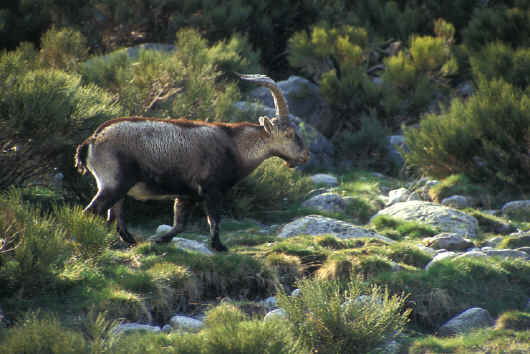Why Wont the Ibex Be Cloned Again

Immature Castilian ibex (Capra pyrenaica), Sierra de Gredos, Spain Photo: Jose Luis GOMEZ de FRANCISCO/naturepl.com
This breaking news this night could have rather far-reaching consequences for cryptozoology. After all, what is the purpose of searching for new animals that you conjecture are merely an animal that has gone extinct, such as the thylacine? What reasons are there for looking for animals once thought extinct that may however be surviving out in the forest, if all you have to practise is merely clone them?

The Pyrenean ibex, a form of wild mountain caprine animal, was officially alleged extinct in 2000 when the final-known brute of its kind was found expressionless in northern Spain.
Soon before its death, scientists preserved peel samples of the caprine animal, a subspecies of the Castilian ibex that live in mountain ranges across the land, in liquid nitrogen.
Using Deoxyribonucleic acid taken from these skin samples, the scientists were able to replace the genetic textile in eggs from domestic goats, to clone a female Pyrenean ibex, or bucardo as they are known. It is the first time an extinct animal has been cloned.
Sadly, the newborn ibex child died soon after nascence due to physical defects in its lungs. Other cloned animals, including sheep, have been born with like lung defects.
Only the breakthrough has raised hopes that it will be possible to salve endangered and newly extinct species by resurrecting them from frozen tissue.
Information technology has also increased the possibility that information technology will one mean solar day be possible to reproduce long-dead species such every bit woolly mammoths and even dinosaurs.
Dr Jose Folch, from the Centre of Food Technology and Research of Aragon, in Zaragoza, northern Espana, led the research along with colleagues from the National Enquiry Institute of Agriculture and Food in Madrid.
He said: "The delivered kid was genetically identical to the bucardo. In species such as bucardo, cloning is the only possibility to avert its complete disappearance."
Pyrenean ibex, which accept distinctive curved horns, were once common in northern Spain and in the French Pyrenees, merely all-encompassing hunting during the 19th century reduced their numbers to fewer than 100 individuals.
They were somewhen declared protected in 1973, but by 1981 simply 30 remained in their last foothold in the Ordesa National Park in the Aragon Commune of the Pyrenees.
The last bucardo, a 13-yr-quondam female known every bit Celia, was found expressionless in Jan 2000 by park rangers most the French edge with her skull crushed.
Dr Folch and his colleagues, who were funded by the Aragon regional government, had, however, captured the bucardo the previous year and had taken a tissue sample from her ear for cryopreservation.
Using techniques similar to those used to clone Dolly the sheep, known as nuclear transfer, the researchers were able to transplant DNA from the tissue into eggs taken from domestic goats to create 439 embryos, of which 57 were implanted into surrogate females.
Just seven of the embryos resulted in pregnancies and only one of the goats finally gave birth to a female person bucardo, which died 7 minutes later due to breathing difficulties, maybe due to flaws in the Dna used to create the clone.
Despite the highly inefficient cloning process and death of the cloned bucardo, many scientists believe similar approaches may be the only mode to save critically endangered species from disappearing.
Research carried out past Japanese geneticist Teruhiko Wakayama raised hopes that even species that died out long ago could be resurrected subsequently he used cells taken from mice frozen sixteen years agone to produce healthy clones.
But attempts to bring back species such as woolly mammoths and even the Dodo are fraught with difficulties. Fifty-fifty when preserved in ice, Deoxyribonucleic acid degrades over time and this leaves gaps in the genetic data required to produce a good for you animal.
Scientists, however, last year published a near-complete genome of the woolly mammoth, which died out around 10,000 years ago, sparking speculation it will be possible to synthesise the mammoth DNA.
Professor Robert Miller, director the Medical Research Council'southward Reproductive Sciences Unit at Edinburgh University, is working with the Royal Zoological Society of Scotland on a project to use cloning on rare African mammals including the northern white rhinoceros.
They take set the Institute for Convenance Rare and Endangered African Mammals in the hope of using breeding technologies to conserve species including the Ethiopian wolf, the African wild dog and the pygmy hippo.
Professor Millar said: "I retrieve this is an exciting advance as information technology does evidence the potential of being able to regenerate extinct species.
"Clearly in that location is some manner to go earlier it can be used effectively, only the advances in this field are such that we will come across more and more solutions to the issues faced."
A number of projects around the world are now attempting to store tissue and DNA from endangered species. The Zoological Club of London and the Natural History Museum have ready the Frozen Ark projection in a bid to preserve Dna from thousands of animals before they disappear entirely.

Source: "Extinct ibex is resurrected by cloning: An extinct brute has been brought back to life for the outset fourth dimension subsequently being cloned from frozen tissue," by Richard Grayness and Roger Dobson, Telegraph, London, 11:47PM GMT 31 Jan 2009
About Loren Coleman
Loren Coleman is one of the world'southward leading cryptozoologists, some say "the" leading living cryptozoologist. Certainly, he is acknowledged every bit the current living American researcher and writer who has near popularized cryptozoology in the late 20th and early on 21st centuries. Starting his fieldwork and investigations in 1960, after traveling and trekking extensively in pursuit of cryptozoological mysteries, Coleman began writing to share his experiences in 1969. An honorary fellow member of Ivan T. Sanderson's Club for the Investigation of the Unexplained in the 1970s, Coleman has been bestowed with similar honorary memberships of the N Idaho College Cryptozoology Guild in 1983, and in subsequent years, that of the British Columbia Scientific Cryptozoology Club, CryptoSafari International, and other international organizations. He was also a Life Member and Distributor of the International Society of Cryptozoology (now-defunct). Loren Coleman'due south daily blog, every bit a member of the Cryptomundo Team, served as an ongoing avenue of advice for the ever-growing torso of cryptozoo news from 2005 through 2013. He returned every bit an infrequent contributor start Halloween week of 2015. Coleman is the founder in 2003, and current director of the International Cryptozoology Museum in Portland, Maine.
E-mail • Facebook • Twitter •
yokoyamawhispiever.blogspot.com
Source: http://cryptomundo.com/cryptozoo-news/ibex-clone/
Post a Comment for "Why Wont the Ibex Be Cloned Again"